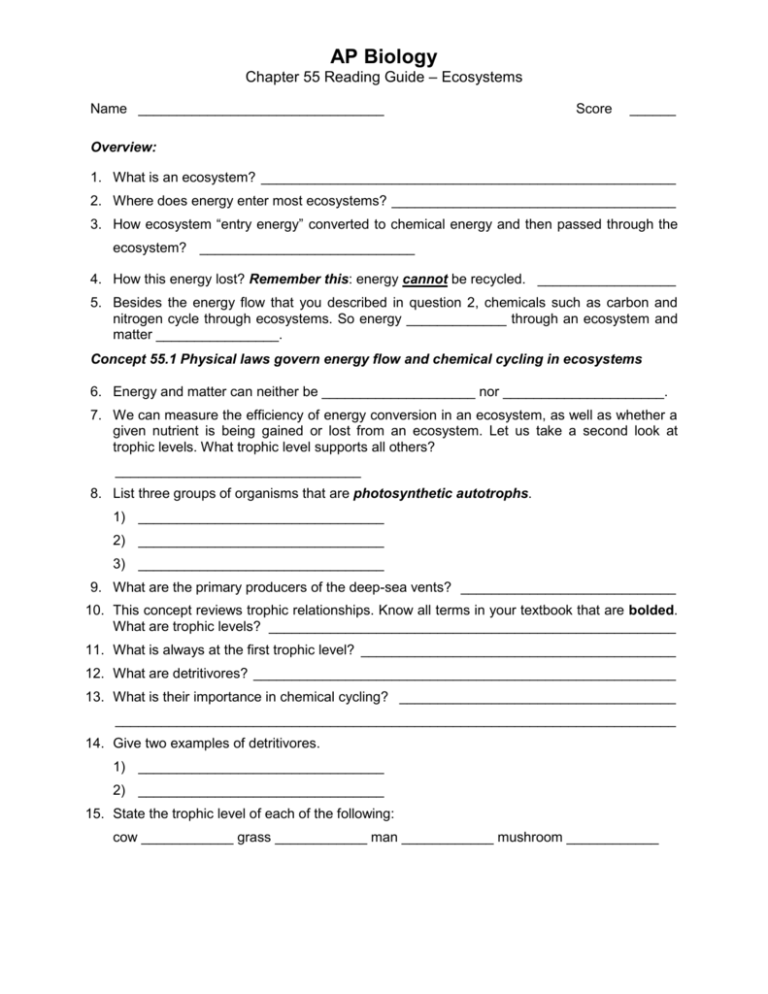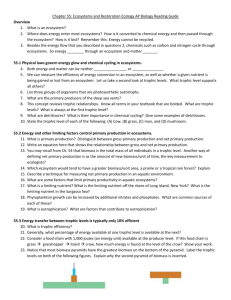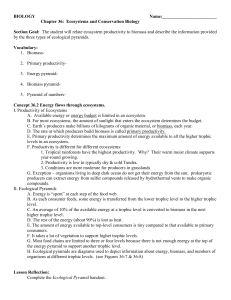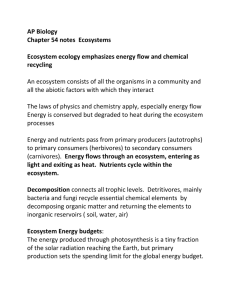Overview:
advertisement

AP Biology Chapter 55 Reading Guide – Ecosystems Name ________________________________ Score ______ Overview: 1. What is an ecosystem? ______________________________________________________ 2. Where does energy enter most ecosystems? _____________________________________ 3. How ecosystem “entry energy” converted to chemical energy and then passed through the ecosystem? ____________________________ 4. How this energy lost? Remember this: energy cannot be recycled. __________________ 5. Besides the energy flow that you described in question 2, chemicals such as carbon and nitrogen cycle through ecosystems. So energy _____________ through an ecosystem and matter ________________. Concept 55.1 Physical laws govern energy flow and chemical cycling in ecosystems 6. Energy and matter can neither be ____________________ nor _____________________. 7. We can measure the efficiency of energy conversion in an ecosystem, as well as whether a given nutrient is being gained or lost from an ecosystem. Let us take a second look at trophic levels. What trophic level supports all others? ________________________________ 8. List three groups of organisms that are photosynthetic autotrophs. 1) ________________________________ 2) ________________________________ 3) ________________________________ 9. What are the primary producers of the deep-sea vents? ____________________________ 10. This concept reviews trophic relationships. Know all terms in your textbook that are bolded. What are trophic levels? _____________________________________________________ 11. What is always at the first trophic level? _________________________________________ 12. What are detritivores? _______________________________________________________ 13. What is their importance in chemical cycling? ____________________________________ _________________________________________________________________________ 14. Give two examples of detritivores. 1) ________________________________ 2) ________________________________ 15. State the trophic level of each of the following: cow ____________ grass ____________ man ____________ mushroom ____________ Concept 55.2 Energy and other limiting factors control primary production in ecosystems 16. What is primary production? __________________________________________________ _________________________________________________________________________ 17. Distinguish between gross primary production and net primary production. _________________________________________________________________________ _________________________________________________________________________ _________________________________________________________________________ 18. In the space below, write an equation that shows the relationship between gross and net primary production. 19. Biomass is the total mass of all individuals in a trophic level. Another way of defining net primary production is as the amount of new biomass added in a given period of time. Why is net primary production, or the amount of new biomass/unit of time, the key measurement to ecologists? _________________________________________________________________________ _________________________________________________________________________ 20. Which ecosystem would tend to have a greater biomass/unit area, a prairie or a tropical rain forest? Explain. _____________________________ Explanation ______________________________________________________________ _________________________________________________________________________ 21. Describe a technique for measuring net primary production in an aquatic environment. _________________________________________________________________________ _________________________________________________________________________ _________________________________________________________________________ 22. What are some factors that limit primary productivity in aquatic ecosystems? _________________________________________________________________________ 23. What is a limiting nutrient? ___________________________________________________ _________________________________________________________________________ 24. What are the limiting nutrients in the following locations: 1) Offshore of Long Island, New York? 2) In the Sargasso Sea? ________________________________________ ___________________________________________________ 25. Phytoplankton growth can be increased by additional nitrates and phosphates. What are common sources of each of these? _________________________________________________________________________ Chapter 55 Reading Guide 2 26. What is eutrophication? ______________________________________________________ 27. What are factors that contribute to eutrophication? ________________________________ _________________________________________________________________________ Concept 55.3 Energy transfer between trophic levels is typically only 10% efficient 28. What is trophic efficiency? 29. Generally, what percentage of energy available at one trophic level is available at the next? This is important! Remember it. 30. Consider a food chain with 1,000 joules (an energy unit) available at the producer level. If this food chain is grass grasshopper lizard crow, how much energy is found at the level of the crow? (See answer at the end of this Reading Guide.) Show your work here. 31. Notice that most biomass pyramids have greatest biomass on the bottom of the pyramid. Label the trophic levels on the figure below. Explain why the second pyramid of biomass is inverted. __________________________________ ___________________________________ ___________________________________ ___________________________________ ___________________________________ ___________________________________ ___________________________________ ___________________________________ ___________________________________ ___________________________________ ___________________________________ ___________________________________ Chapter 55 Reading Guide 3 32. Why do people who have limited diets in overpopulated parts of the world eat low on the food chain? _________________________________________________________________________ _________________________________________________________________________ Concept 55.4 Biological and geochemical processes cycle nutrients between organic and inorganic parts of an ecosystem 33. Use the figure below to describe the water cycle. Specify the roles of evaporation, transpiration, and rainfall. 34. Use the figure below to describe the carbon cycle. In doing so, explain how carbon enters the living system and how it leaves, indicate the role of microorganisms in the cycle, and identify the reservoir for carbon. Chapter 55 Reading Guide 4 35. Use the diagram below to describe the nitrogen cycle. In doing so, indicate the role of microorganisms in nitrogen fixation, nitrification, and denitrification. 36. Review the Case Study: Nutrient Cycling in the Hubbard Brook Experimental Forest. What effect has deforestation been shown to have on chemical cycling? 37. Write the equation for photosynthesis in the space below. 38. Write the equation for cellular respiration in the space below. Concept 55.5 Human activities now dominate most chemical cycles on Earth 39. How has agriculture affected nitrogen cycling? ___________________________________ _________________________________________________________________________ 40. What are some negative consequences of nutrient enrichment? _________________________________________________________________________ _________________________________________________________________________ 41. In what ways have human activities contributed to acid precipitation? _________________________________________________________________________ _________________________________________________________________________ Chapter 55 Reading Guide 5 42. What are some negative consequences of acid precipitation? _________________________________________________________________________ _________________________________________________________________________ 43. Explain the process of biological magnification and include at least one example. _________________________________________________________________________ _________________________________________________________________________ _________________________________________________________________________ _________________________________________________________________________ 44. What is meant by the greenhouse effect? _________________________________________________________________________ _________________________________________________________________________ 45. What would life on Earth be like without this effect? _________________________________________________________________________ _________________________________________________________________________ 46. What is contributing to the great increase in atmospheric carbon dioxide? _________________________________________________________________________ _________________________________________________________________________ 47. What are potential effects of this increase? _________________________________________________________________________ _________________________________________________________________________ 48. How is atmospheric ozone depleted? _________________________________________________________________________ _________________________________________________________________________ 49. What are projected effects of this depletion? _________________________________________________________________________ _________________________________________________________________________ Testing Your Knowledge: Self-Quiz Answers 1. ________ 2. ________ 3. ________ 4. ________ 5. ________ 6. ________ 7. ________ Solution to Question 22: Grass (1,000 J) grasshopper (100 J) lizard (10 J) crow (1 J) Chapter 55 Reading Guide 6










